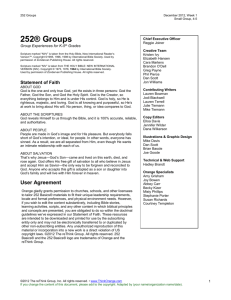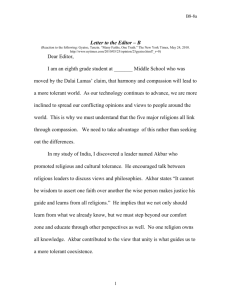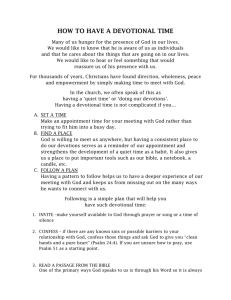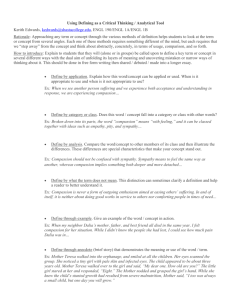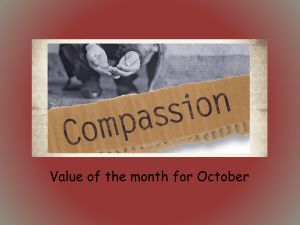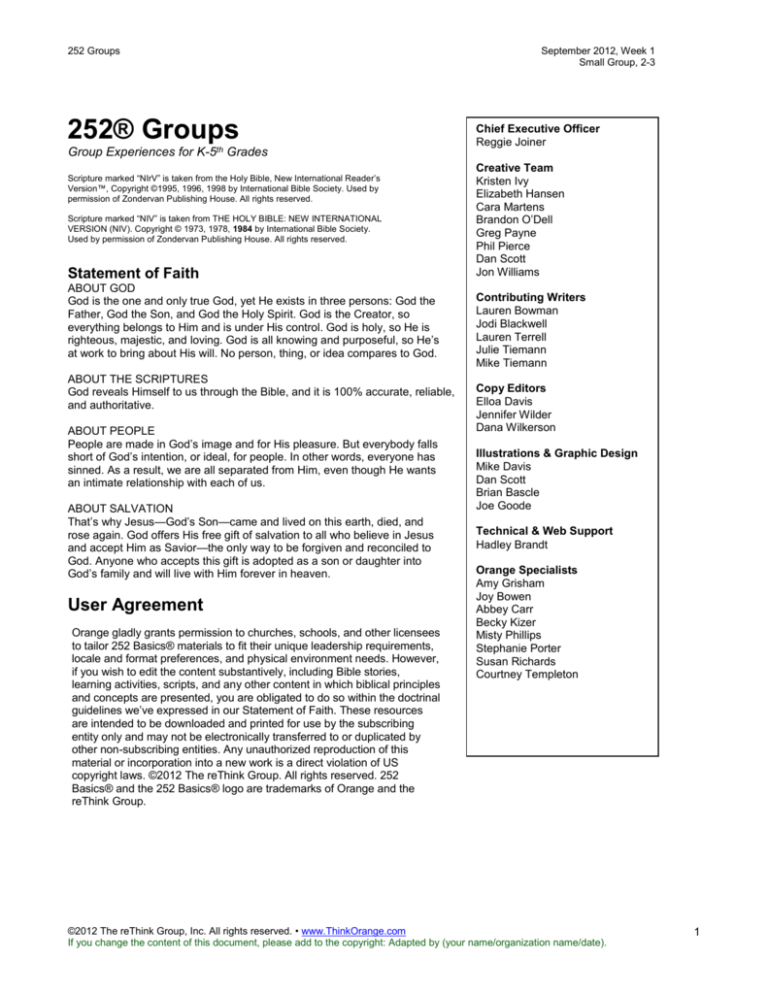
252 Groups
252® Groups
Group Experiences for K-5th Grades
Scripture marked “NIrV” is taken from the Holy Bible, New International Reader’s
Version™, Copyright ©1995, 1996, 1998 by International Bible Society. Used by
permission of Zondervan Publishing House. All rights reserved.
Scripture marked “NIV” is taken from THE HOLY BIBLE: NEW INTERNATIONAL
VERSION (NIV). Copyright © 1973, 1978, 1984 by International Bible Society.
Used by permission of Zondervan Publishing House. All rights reserved.
Statement of Faith
ABOUT GOD
God is the one and only true God, yet He exists in three persons: God the
Father, God the Son, and God the Holy Spirit. God is the Creator, so
everything belongs to Him and is under His control. God is holy, so He is
righteous, majestic, and loving. God is all knowing and purposeful, so He’s
at work to bring about His will. No person, thing, or idea compares to God.
ABOUT THE SCRIPTURES
God reveals Himself to us through the Bible, and it is 100% accurate, reliable,
and authoritative.
ABOUT PEOPLE
People are made in God’s image and for His pleasure. But everybody falls
short of God’s intention, or ideal, for people. In other words, everyone has
sinned. As a result, we are all separated from Him, even though He wants
an intimate relationship with each of us.
ABOUT SALVATION
That’s why Jesus—God’s Son—came and lived on this earth, died, and
rose again. God offers His free gift of salvation to all who believe in Jesus
and accept Him as Savior—the only way to be forgiven and reconciled to
God. Anyone who accepts this gift is adopted as a son or daughter into
God’s family and will live with Him forever in heaven.
User Agreement
Orange gladly grants permission to churches, schools, and other licensees
to tailor 252 Basics® materials to fit their unique leadership requirements,
locale and format preferences, and physical environment needs. However,
if you wish to edit the content substantively, including Bible stories,
learning activities, scripts, and any other content in which biblical principles
and concepts are presented, you are obligated to do so within the doctrinal
guidelines we’ve expressed in our Statement of Faith. These resources
are intended to be downloaded and printed for use by the subscribing
entity only and may not be electronically transferred to or duplicated by
other non-subscribing entities. Any unauthorized reproduction of this
material or incorporation into a new work is a direct violation of US
copyright laws. ©2012 The reThink Group. All rights reserved. 252
Basics® and the 252 Basics® logo are trademarks of Orange and the
reThink Group.
September 2012, Week 1
Small Group, 2-3
Chief Executive Officer
Reggie Joiner
Creative Team
Kristen Ivy
Elizabeth Hansen
Cara Martens
Brandon O’Dell
Greg Payne
Phil Pierce
Dan Scott
Jon Williams
Contributing Writers
Lauren Bowman
Jodi Blackwell
Lauren Terrell
Julie Tiemann
Mike Tiemann
Copy Editors
Elloa Davis
Jennifer Wilder
Dana Wilkerson
Illustrations & Graphic Design
Mike Davis
Dan Scott
Brian Bascle
Joe Goode
Technical & Web Support
Hadley Brandt
Orange Specialists
Amy Grisham
Joy Bowen
Abbey Carr
Becky Kizer
Misty Phillips
Stephanie Porter
Susan Richards
Courtney Templeton
©2012 The reThink Group, Inc. All rights reserved. • www.ThinkOrange.com
If you change the content of this document, please add to the copyright: Adapted by (your name/organization name/date).
1
252 Groups
September 2012, Week 1
Small Group, 2-3
FOR LEADERS ONLY
GOD VIEW: the connection between COMPASSION and God’s character,
as shown through God’s big story
If you want to understand who God is—if you want to learn more about His character—there may be no
better place to start than with the Christmas story.
The Creator of the entire universe was attentive to His creation. He saw and understood the
consequences of our sin. He saw our greatest need. And He did something about it. He humbled
Himself to be born as a tiny baby in a remote town in the dwelling place of animals. He lived as one of
us so that, eventually, He could die for us and rise again, giving us the chance to live eternally with God
in heaven.
This Christmas story shows that one aspect of God’s character is compassion. COMPASSION is
caring enough to do something about someone else’s need. God lovingly saw our greatest need
and met it in the most remarkable way.
People with very real and practical needs surround us. Let’s train our eyes to see their hurts and teach
our hearts to step outside our comfort zone. When we can imagine ourselves in someone else’s shoes,
take action, and do what is in our ability to help them, we reflect God’s COMPASSION into the world.
We may not be able to meet every need or solve every problem, but we can start somewhere and do
something. As we demonstrate more COMPASSION, we will see ourselves transformed to be more like
God.
This month, let’s think about how:
(1) God showed compassion to us when He sent His Son to meet our greatest need.
(2) We reflect the character of God to the world around us when we meet others’ needs.
(3) As we demonstrate compassion to others, we experience transformation in our own life and
begin to discover more about God’s great compassion.
This week, we’re discovering:
In this week’s Bible story, we see God begin His compassionate rescue by sending Gabriel to appear to
Mary (Luke 1:26-38). Gabriel tells Mary that God has seen His people’s need, and Mary gets to be a
part of God meeting that need. Immanuel—God with us—is coming to rescue us!
Our Bottom Line is God saw our greatest needs. Whose needs do you see? When we slow down
and look outside ourselves, we see the needs of those around us. But when we stay focused on our
own needs, we miss the chance to help others.
The monthly memory verse summarizes God’s example of compassion: God loved the world so
much that he gave his one and only Son. Anyone who believes in him will not die but will have
eternal life. John 3:16, NIrV God saw the world’s greatest need and cared enough to do something
about it.
©2012 The reThink Group, Inc. All rights reserved. • www.ThinkOrange.com
If you change the content of this document, please add to the copyright: Adapted by (your name/organization name/date).
2
252 Groups
September 2012, Week 1
Small Group, 2-3
Mama Mia!
Bible Story: Mama Mia! (Gabriel appears to Mary) • Luke 1:26-33
Bottom Line: God saw our greatest needs. Whose needs do you see?
Memory Verse: “God loved the world so much that he gave his one and only Son. Anyone who
believes in him will not die but will have eternal life.” John 3:16, NIrV
Life App: Compassion—caring enough to do something about someone else’s need.
Basic Truth: I can trust God no matter what.
Plug In: Focus the Energy (Small Groups, 10-15 minutes)
Focus the energy on today’s Bible story in a Small Group setting with an engaging discussion question
and an interactive opening activity.
Before students arrive, pray for each regular attendee by name. Pray for those who might visit your
class for the first time. Pray that God would help the kids understand that we really do need rescuing
and help. Thank Him for sending Jesus. Pray that God will help the kids identify some of the greatest
needs that people around them have—and then do something about it.
1. Early Arriver Idea
What You Need: an offering container
What You Do:
Invite kids to put their offerings in the offering container. Ask them what their your favorite Christmas
movie, story, or character is. Make a list of their responses (either in your head or on paper) and then
play an impromptu game of charades using that list!
2. Who Sees Your Needs?
What You Need: large sheet of butcher paper, markers
What You Do:
Introduce the idea that we all have needs like food, water, shelter, and clothes. Write down these needs
and brainstorm others on a large piece of butcher paper. Then play a game of “telephone.” Each child
comes up with a sentence of how someone in their life sees their needs. (e.g.: My dad gives me milk
with dinner. My teacher takes us outside to the playground.) Sitting in a circle, one person whispers the
sentence into the ear of the person to the right. The sentence goes around the circle with each person
only saying it once then quietly passing on. When the last person hears the sentence, he or she says it
aloud.
What You Say:
[Transition] “Let’s head to Large Group and hear a story about what God did about our greatest
need of all!”
Lead your group to the Large Group area.
©2012 The reThink Group, Inc. All rights reserved. • www.ThinkOrange.com
If you change the content of this document, please add to the copyright: Adapted by (your name/organization name/date).
3
252 Groups
September 2012, Week 1
Small Group, 2-3
Catch On: Make the Connection (Small Groups, 25-30 minutes)
Make the connection of how today’s Bible story applies to real life experiences through interactive
activities and discussion questions.
2. Do You See What I See? (application activity / great for boys)
What You Need: “Do You See What I See” (Activity Page)
What You Do:
Pair up the students in your group. Hand each pair a script to read aloud or act out for the Small Group.
Give the group five minutes to look over their scripts, decide who will play which role, and come up with
a plan. Ask for a volunteer pair to go first. Act as the director, calling “Action!” before each script. After
each script, discuss as a group what need(s) they saw and what they could do about that need.
What You Say:
“Sometimes other people’s needs are right in front of our faces and we don’t even know it!
[Personalize] (Tell about a time when you saw and met someone’s need. This could be anything
from volunteer work to opening a door for someone whose hands were full.) Just like God saw
our need for a Savior and cared enough to do something about it, [Apply] let’s all open our eyes to
see the needs around us—and care enough to do something about them! [Impress] God saw
our greatest needs. Whose needs do you see?”
Pray and Dismiss
What You Need: no supplies necessary
What You Do:
Pair students with same partners as in “Do You See What I See?” skit activity (or choose new ones).
Tell everyone to think of one person they know in the church, at school, their family, or their community
who has a need. Then, give partners three to four minutes to share that need (make sure to emphasize
the importance of not sharing names with their partner—they can come up with a nickname but no
actual names), [Apply] brainstorm ways to do something about those needs, and pray for those
people out loud together with their partner. Come back together as a group and allow students to
share if they would like.
What You Say:
“Sometimes, it can be hard to know what to do about someone else’s need. We may see a need like a
kid without water or food or a neighbor with no car, but not really know how we can help. That’s when
talking with others and prayer comes in! When you see a need that you think is too big for you to do
something about, turn to a parent or friend and together, ask for God’s help in showing compassion.
Let’s pray.
“Dear God, thank You so much for seeing our greatest need and sending Your Son, Jesus. Help us to
show compassion too by seeing the needs around us. And when we see those needs, help us to know
the best way to help or who to ask to partner up. We love You. In Jesus’ name, Amen.”
Give each child a GodTime card. Pass out Parent CUE cards as adults arrive for pick-up.
©2012 The reThink Group, Inc. All rights reserved. • www.ThinkOrange.com
If you change the content of this document, please add to the copyright: Adapted by (your name/organization name/date).
4

